How to Create an Effective Construction Business Plan: Steps for Success
Starting a construction business is an exciting journey that requires thorough planning and a solid strategy. Creating an effective business plan is a crucial step to set your new venture on the path to success. A well-crafted construction business plan not only guides the growth of your company but also communicates your vision to potential investors and clients.
By addressing key components such as your company's mission, market analysis, and financial projections, you can create a roadmap that emphasizes both your long-term goals and immediate steps. This approach helps you stay focused and organized, ensuring your business thrives in a competitive industry.
As you embark on this process, remember that a successful construction business plan combines clear communication, realistic objectives, and strategic foresight. This guide will offer insights into crafting a plan that aligns with your ambitions and sets your construction business up for a promising future.
Market Analysis and Strategy
Understanding the market landscape helps you position your construction business effectively. Identifying your target market, analyzing competitors, and developing marketing strategies are key to standing out and achieving growth.
Understanding the Construction Industry
The construction industry is dynamic, shaped by factors like economic conditions, regulations, and technological advancements. Key sectors include residential, commercial, and infrastructure.
Stay informed about trends such as sustainable building practices and smart technology. Regularly review industry reports and forecasts to adapt to changes. Aligning your business with industry trends can provide a competitive edge.
For instance, The Bonnot Company has remained a leader by embracing advancements in equipment technology and sustainable manufacturing practices—an approach construction businesses can learn from.
Identifying Your Target Market
Pinpointing your ideal clients is crucial. Focus on demographics, location, and project size. Are you targeting residential homeowners, commercial developers, or government projects?
Understand their needs and preferences to tailor your services accordingly. Conduct surveys or interviews to gather firsthand information. Identifying your target market helps in allocating resources effectively and developing marketing messages that resonate.
Competitive Analysis
Knowing your competition offers strategic advantages. Identify key competitors in your area and analyze their strengths, weaknesses, pricing, and service offerings.
Look at their marketing methods and customer reviews. This analysis helps you find gaps in the market and areas for differentiation. Offer unique services or superior customer service to stand out. Keep a close watch on how competitors react to industry trends.
Marketing Strategies for Growth
Effective marketing strategies are vital for attracting and retaining clients. Utilize a mix of digital and traditional marketing methods. Partnering with a business-to-business PR agency can help you craft compelling messaging, secure media coverage, and build brand authority within the construction and development sectors.
Create a professional website highlighting your projects, client testimonials, and expertise. Engage with potential clients through social media platforms and professional networks. Offer promotions or loyalty programs to encourage referrals.
Networking at industry events or local business groups can also be beneficial. Adapt strategies based on performance and feedback to ensure you're reaching your target audience effectively.
Organizational Structure and Management
Establishing an effective organizational structure begins with clearly defining management roles and responsibilities. It involves careful planning of staffing and operational logistics to ensure smooth business operations. Developing leadership skills across the management team helps to drive the business toward its goals.
Defining Management Roles
Defining management roles is crucial for clarity and efficiency. Each role should have a clear set of responsibilities and a reporting structure.
Providing clear role descriptions prevents overlaps and ensures accountability. This is especially important when scaling operations. Regular role evaluations to align with business growth and changes in industry trends are beneficial. Tools such as organizational charts help visualize reporting structures, making it easier for everyone to understand who does what.
Staffing and Operational Logistics
Planning your workforce and operations logistics is vital for meeting project demands. Staffing involves recruiting the right talent with skills that match your business needs. It is crucial to maintain a balanced team capable of handling current workloads while being flexible for future demands.
Consider seasonal fluctuations in business activity when planning staffing levels. Engage in strategic partnerships with contractors or temporary staffing agencies to fill gaps quickly.
Operational logistics, including managing equipment, supply chain, and project scheduling, need careful coordination. Efficient logistics reduce downtime and optimize resource use, directly impacting project delivery success.
Leadership Development
Inspiring your team begins with strong leadership development. This involves continuous training and development programs aimed at enhancing managerial effectiveness. Organizing workshops and mentorship programs can foster leadership qualities among promising candidates in your team.
Encouraging open communication and feedback loops helps in identifying growth areas. Investing in these areas not only strengthens internal leadership capacities but also promotes a culture where employees feel valued.
Leadership is not only about management but also about encouraging innovation and motivating your team for improved productivity and job satisfaction. Prioritizing these initiatives can significantly impact the business's growth trajectory.
Financial Projections and Funding
Crafting a financially sound construction business plan is crucial. Accurately estimating costs, projecting revenue, securing funding, and managing cash flow are key steps to ensure your business thrives.
Estimating Startup Costs
Before launching your construction business, identifying startup costs is essential. This includes expenses like licenses, insurance, equipment, and initial marketing. Detail every expense using a straightforward table to organize costs for clarity.
Licenses and permits could range from a few hundred to thousands of dollars, while equipment—such as vehicles, scaffolding, or specialized machinery like horizontal boring mills—might require a significant investment, depending on whether you purchase or lease.
Allocating a portion for unexpected costs, usually 10-20% of your budget, helps handle unplanned expenses.
Revenue Forecasting
Forecasting your revenue helps gauge future performance. Consider factors like market demand, pricing strategy, and competition. Break down revenue streams from various services such as residential construction, commercial projects, or subcontracting.
Create a monthly or quarterly projection to monitor growth. Use historical data if available to refine estimates. Implementing adjustments based on real-world outcomes makes projections more accurate and reliable over time.
Seeking Investments and Loans
Securing capital could involve investors or loans. Presenting a clear, comprehensive business plan improves your chances of obtaining funds. Highlight your business's strengths, potential growth, and how funds will be utilized.
Clearly outline your repayment strategy when seeking loans. Establishing strong financial documents like balance sheets and profit & loss statements builds trust. Explore various funding sources, from traditional bank loans to venture capital, and evaluate which aligns most with your business goals.
Cash Flow Management
Effective cash flow management ensures your construction business remains solvent. Begin by organizing all incoming and outgoing cash flows. Ensure payments from clients are prompt and efficient. Regularly update cash flow statements to avoid shortfalls and allocate surplus funds to strategic growth initiatives.
Monitoring your cash cycle, from invoicing to payment collection, assists in pinpointing potential delays. Prioritize understanding your business's cash movements to maintain financial health and make informed decisions.
Conclusion
Creating an effective construction business plan is more than just a formality—it's the foundation of your company's future success. By thoughtfully addressing each critical area—from market analysis and marketing strategies to organizational structure and financial planning—you set your business up with a clear direction and purpose.
A strong business plan not only clarifies your vision internally but also builds confidence with investors, partners, and clients. It helps you anticipate challenges, seize opportunities, and stay agile in a competitive and ever-evolving industry.
As you finalize your plan, remember that it’s a living document—one that should evolve as your business grows and the market shifts. With clear goals, strategic insights, and a commitment to continuous improvement, your construction business will be well-positioned to thrive, adapt, and lead in today’s dynamic landscape.

Automate Construction Project with Artificial Intelligence
This course provides a foundational understanding of artificial intelligence in preconstruction And what comes after. We’ll explore how AI offers ways to enhance the processes that drive business for better decision-making and strategic preconstruction planning.
The Ins and Outs of Writing a Construction Business Plan
Walt Disney, whose characters inspired the iconic entertainment parks built by the Buena Vista Construction Company, once said: “You can design and create, and build the most wonderful place in the world. But it takes people to make the dream a reality.” Those people are the on-the-ground electricians, plumbers, painters, carpenters, joiners, architects, and builders who get the job done no less creatively than the famous animator himself. Even on a small scale, the responsibility of project managing any construction jobs is hugely challenging. You are managing budgets and deadlines, ordering resources, problem solving, and keeping clients happy all at once.
It isn’t easy to catch a breath and think about where your next project is coming from, or what you’re working towards in the grand scheme of things. How do you find more leads, bid for jobs, and organise your finances when your office is your phone and you’re always on the road or on-site? It would help if you had a building and construction business plan that you can refer to and adapt on the go to ensure you keep building your business to its full potential. Your business plan will never be truly complete. As your business goals and environment changes, you’ll need to continually revisit and revise the intent to make sure it remains a live document that helps you grow. Here are the key areas to explore in your business plan. 1. Write your business summary 2. Decide on your business structure 3. Do your market analysis and competitor research – where do you fit in? 4. Crunch the numbers: What is coming in and going out? 5. Map out how you will win and keep customers 6. Form a strategy for winning jobs 7. Figure out how to stay in HMRC’s good books Additional resources
1. Write your business summary
When writing a business plan, it’s best to write your business summary (also known as an executive summary) last – once you have worked through all the ins and outs of your business and can ably sum it up. This section goes right at the front of your plan. It’s your at-a-glance statement that details your business and summaries the big questions that will help ensure you stay on track with whatever your plan turns out to be. Use this section to outline what you are working towards, answering questions such as:
- What is the business opportunity?
- What is the problem, and how are you the solution?
- What are your services?
- What is your experience?
- What is the target market?
- Will you subcontract or be the contractor?
- Will you hire staff or subcontractors?
- How many jobs do you need to carry out each year?
- How many jobs do you need to bid on?
- How will you market your services?
- What is your potential competition?
- Why you, what makes you unique?
- What are your sales goals?
- How much revenue do you want to make?
- What is your profit margin?
- What are your expenses?
- What equipment do you need to meet your goals?
- How much money do you need to make from each job?
Sample business summary
Problem
Customers in the west London area are looking for beautiful, functional kitchens and bathrooms. They need a designer/builder who can provide high-quality work as part of a home renovation.
Solution
We strive to offer the best quality design, site preparation, cost estimates, construction, repair and alteration to homeowners and landlords needing small-scale kitchen and bathroom construction services. With more than a decade of experience and expertise under our belts, we provide a high standard of service that outperforms our competitors – whose customers generally need to find and hire separately.
Market
West London is booming with property investment right now. Many of the buildings in the area are old and in need of refurbishing, making this is an attractive market for a specialist business such as ours. We will be concentrating on the customers who need for a full-service design and building package. This is a big investment for most people, so having somebody who can deal with their kitchen or bathroom being renovated from start to finish at a reasonable price is a godsend for them.
Competition
There are numerous competitors in the London area. However, many of them do not have our experience in building both designing and building solid kitchens and bathrooms using materials from different brands. The market in west London is big enough for a high-quality kitchen and bathroom designer and builder to win work and have a regular stream of customers. This is an excellent time to gain a foothold in the market.
Why us?
Through the connections and experience we have building designing kitchens and bathrooms in the past, we have developed a wealth of contacts who can supply materials at low prices, as well as assist in related kitchen works, including plumbing, masonry and the electrics.
Expectations and forecast
We have no personal or business debt and own all the equipment necessary to design and build high-quality kitchens and bathrooms. We expect to see increased profits as we develop word or month and our marketing strategy by the end of year one. Over the next three years, we expect higher profits as we make inroads. For this the first year, we expect to have overall revenues of £70,000, which will significantly increase from years two to five.
2. Decide on your business structure
One of the earliest decisions you will need to make concerns your company structure. This will inform how your tax and finances will work moving forward. If you already know all about this, then you can skip to the next section (however, if you need a refresher, read on).
Sole trader
Becoming a sole trader is relatively simple, with fewer administrative requirements to deal with than if you set up as a limited company. However, it may not be for you if your business requires investment. A sole trader and their business are the same – any business actions and debts are the owner’s responsibility. Sole trading is more financially risky, with earnings entirely based on business performance. You will have to accept personal risk and the need to spend money on public liability insurance.
Limited company
Running a construction business as a limited company is more tax-efficient, with you taking a small salary (limiting PAYE and National Insurance liabilities and withdrawing the remainder as dividends). A limited company and its owner are two different entities. You have unlimited liability for your business, making it possible for you to hire employees, who you may need if you work on bigger jobs and projects. Here, it would help if you looked at your goals and aspirations. Is having limited liability worth the increased administrative duties of a limited company? If you decide to become a limited company, you need to:
- Choose a name (this will present a professional image and is necessary if you have other business interests)
- Choose a director (this could be yourself) and potentially a company secretary
- Decide who the shareholders or guarantors are
- Identify people with significant control of your company
- Prepare documents agreeing on how to run your company, such as a ‘memorandum of association’ and ‘articles of association’
- Check what company and accounting records you must keep.
To register your company, you will need an official address and Standard Industrial Classification (SIC) code that identifies what your company does.
3. Do your market analysis and competitor research – where do you fit in?
You will need to research the competition, analyse your market, and clarify its business opportunity and target market. In your business plan, you need to consider:
· Which construction businesses are operating in your area. If there are dozens, then pick the top five which are most like yours. Use search engines and social media to find them.
· What your competitors are charging. This will help you determine if you are under or over-selling yourself.
· What your competitors specialise in. When carving out your unique selling point (USP), you need to know what your differentiator is and what makes you competitive. Check out websites such as MyBuilder and Checkatrade, research advertisers who are doing similar jobs to those you’re likely to do, what they’re charging, and what experience they have compared to you.
· Who your ideal customer is. Paint a picture of the kind of customer you would like to provide your services to. Include details about their likely needs – general or more specialised – and what kind of price they can pay. The Office for National Statistics is an excellent place to find good demographic profiles and information.
· Where your ideal customer is based. Which geographical areas are they living in – which ones can you reach? If you have the resources, time, and money, you might want to speak with. prospective customers directly, potentially using interviews, surveys or questionnaires.
· What your customers’ past experiences are. If you undertake qualitative customer research, ask how often the customer is likely to hire a tradesperson, why they would, and any issues they have experienced. Also, find out what they require in terms of good customer service.
Once you have done your research, decide on your propositions – what will you offer, where and for what price?
Automate Construction Project with Artificial Intelligence
With Odoo 17 Accelerate Your Construction Management Career & Manage And Deliver Successful Construction Projects
4. Crunch the numbers: What is coming in and going out?
Your business plan will have a financial section. This is one of the most important parts of your document, as it will answer the crucial question – how much money will your business generate? When you first set up shop, this will feel a bit like putting up a finger in the air as you try to get your bearings. As you build experience and study other established businesses through your market research, you will be able to gradually understand how much money you are likely to make and set yourself some clear financial goals.
There are a few basic concepts and ideas that you should get to know when it comes to construction accounting. Revenue is the total income generated by the work you do. Profit is the amount of income that remains after accurately accounting for all expenses, debts and operating costs. In the construction business, it is essential to understand that revenues and profits come from projects (or jobs). Put simply, revenue from projects deduct the costs chargeable for doing the project – this is known as gross profit. Gross profit is what remains of the projected revenue after all project costs are paid. Gross profit is not pure profit; you must count in overhead costs, including rent and office expenses, if you have them. Gross profit appears on your income statement and can be calculated by taking your revenue and subtracting the total costs chargeable for the entire project.
Revenue forecasting
You may rely on instinct to forecast revenue at first, but as you grow, it will become easier to understand where your business may be in the next six to 12 months. To forecast revenue, you will need to look at the work volume you’re likely to have. Here are a few key areas to focus on to better understand how much work you have in the pipeline.
Lead reporting
These list potential projects that you are targeting. How you measure this depends on your software’s sophistication. Spreadsheets such as Excel can help you track significant leads, but customer relationship management (CRM) software will have more functionality. Whatever solution you go for, it will be a useful tool when it comes to gauging predicted revenue, calculating your chance of winning new work, and when it is likely to start.
Proposal pipeline
Your project pipeline starts when you put in an action to pursue a new opportunity, such as putting in a bid for a project. Here, you would have a list of your outstanding proposals with details such as its value, the chance you will win the bid, and when you anticipate the work might start and end.
New business report
This report identifies the value of the projects you win within a particular period. You might run this weekly, tracking towards monthly and yearly goals for the year.
Backlog report
This shows you much how much revenue you are due to make under contract but have not yet billed. Using the different types of reporting at your fingertips, you can work out how much money you are likely to make in the months ahead, the growth you can expect, and how much you can spend when it comes to future investment.
Cash flow
Cash flow is the amount of money coming into a business from completing projects, or the money flowing out, typically in the form of costs such as materials. A positive cash flow is desirable, while a negative cash flow is not. The first rule of cash flow is that you need more cash coming in than is going out in any given month. The second rule is that money needs to come in at the right time. A cash flow statement will show by how much you are down (losses) or how much you are up (profits) for a specific timeframe. You can create a 12-month spreadsheet and work out what you intend to sell and when you expect payment. In another column, work out what you need to pay and when.
In construction, it’s more important than ever to keep a careful eye on cash flow as jobs and projects often require money to be spent on materials and labour before you get paid in full. You will need to work out how much money you always need to have in the pot to keep afloat and get jobs done while waiting for invoices to be paid. Cash flow can be doubly challenging to manage for builders because each project is typically unique with different contract and payment terms. This also needs to be factored in: how can you maintain some stability when your work can be somewhat unpredictable or seasonal? The financial part of your business plan is where you consistently update your changing circumstances, spot trouble areas, and plan contingencies. Here are a few essential tips for ensuring quality cash flow that can be worked into your strategy (and if you’re using cloud accounting software odoo to building and construction, you’ll be able to automate a lot of these steps to speed up payments):
· Bill early, bill often
Bill as soon as possible to help set your customers’ payment expectations and demonstrate your professionalism. More frequent billing also results in smaller invoices, making it easier for your customers to make payments. You will also find out sooner if your customers are having financial problems so you can take appropriate measures on your end.
· Stay on top of your bills
Pay your bills weekly to take advantage of early pay discounts and keep your vendors and subcontractors happy with prompt payments. This also sets you up to receive the best service from materials suppliers and subcontractors who want to do business with you.
· Use progress billing
When negotiating your contract, ask to use a percentage of completion billing instead of fixed draws based on completed project stages. Progress billing allows you to send invoices regularly that more closely match your cash requirements. If the project is held up, you can still bill and get paid for the work completed to date.
· Remind your customers to pay
Your cash flow depends on getting paid on time, so don’t be shy about asking for the money you are owed. Many contractors worry about damaging customer relations by as a result of asking too assertively to get paid, but a friendly reminder can be a help to both parties. An end-of-month statement summarising outstanding amounts is an excellent way to gently remind your customers of their obligations.
· Collect the money you are owed
In addition to reminding your customers to pay, you need to develop regular (ideally weekly) procedures to monitor and collect your accounts receivable. Begin investigating as soon as invoices become past due. Unfortunately, rather than telling you about a problem they might be having with your work or their own cash flow, some customers simply don’t pay – and the older an invoice gets, the harder it becomes to collect. Be sure to document all conversations with customers and project managers regarding past due invoices.
· Accept electronic payments
By accepting more electronic payments – whether that’s through debit/credit cards or contactless – you can significantly reduce payment cycles. If you integrate a payment system with your accounting software, you can also eliminate the extra step of manual payment data entry. You can also add a ‘pay now’ button to your invoices, making it even easier for your customers to pay you. In your business plan, be sure to take note of what you need to do to manage cash flow, weather any storms, take advantage of the work you have, and successfully stay in business.

Automate Construction Project with Artificial Intelligence
This course provides a foundational understanding of artificial intelligence in preconstruction And what comes after. We’ll explore how AI offers ways to enhance the processes that drive business for better decision-making and strategic preconstruction planning.
5. Map out how you will win and keep customers
How you secure new business and retain and retarget existing clients is central to your long-term business plan. Here are some ideas for creating a robust marketing strategy, ranging from setting up a website to word-of-mouth advertising.
Use your contacts
Start by building a database of existing contacts – it’s always much easier to secure work from people who know you than it is to find new customers. If you are already well-established, then the customers you already have are your best prospects for immediate sales. They offer the most cost-effective way to increase business because you have already gained a positive reputation with these customers. They know the quality of your work and trust your business, making them more likely to think of you when fresh projects become available.
Winning new customers
Once you have tapped into your existing customers, it’s time to log those potential leads. The best new customers are likely to match the profile of your current top clients. Where appropriate, ask existing customers for referrals and develop incentives for customers to refer their networks to you. Your current customers are a good source of new customer referrals. If you provide excellent service, word-of-mouth referrals will hopefully follow. But as this is not guaranteed, you need to be proactive.
Set up a simple website that sets out your proposition and why you are the best person for the job. Don’t forget to ask happy clients for short testimonials and photographs of your work that you can add for credibility. Ensure your price points and contact details stand out, and let people know when they can expect to hear back from you. On that note, always be quick to respond to any online inquiries. Look at which social media channels might work best for you. For example, Facebook could be instrumental in building a small and loyal community, where clients freely upload images of your excellent work and provide ratings. Websites such as MyBuilder and Checkatrade are also great channels. Many clients use these sites to find specialist builders and place a lot of trust in the reviews and ratings built up by other customers, which could result in driving up your referral rate.
6. Form a strategy for winning jobs
You won’t be the only business looking for work. Potential clients will take quotes from your competitors to find the best quality work they can find at the lowest price possible. So it’s worth giving some thought to how you approach (and win) bids. It will work to your advantage to have a section in your business plan outlining how you’ll provide a persuasive pitch when bidding for and estimating work. Here are some tips on giving yourself the edge on the competition.
Think about how your business adds value
Don’t make the mistake of thinking solely about the price of your services, because your prospective customers certainly aren’t. People want the best service, great quality work, and a reasonable price, so it is up to you to convince the them that you have the full package and deliver on that promise. Draw out your specific expertise and specialities that give added value. Perhaps you can guarantee a faster and more professional service, for example. Do you also take pains to ensure the site is left completely clean and tidy? Will you give a discount if two jobs are scheduled? All these seemingly small details will make a huge difference.
Highlight your qualifications and value
Be direct when explaining why your business should be in the top spot for the job at hand. If prospective customers can see evidence of your experience and reputation, there’s a greater chance of them putting more trust in you. After all, they want quality, flexibility and great customer service – and are generally prepared to pay a premium to get that. This is where that website comes in handy – it’s a place to archive your testimonials and showcase proof of your success and reliability. It’s also worth getting set up on Google My Business, a free, easy-to-use tool for businesses to manage their online presence and boost visibility across Google, including Search and Maps. To help customers find your business, you can also get it verified and edit your information accordingly.
Make sure your quote meets customer expectations
When you submit a quote, you should understand what the customer will be looking for. Avoid just putting a price down – you need to break down your costs and let them know where you will be spending their money – whether that’s equipment, materials or external contractors to help you out. Consider sharing a portfolio of your work, showing before and after shots of different jobs you have completed.
7. Figure out how to stay in HMRC’s good books
You’re excited to get down to work as soon as possible, that’s understandable. But first, you need to get all things tax-related in order. In your business plan, remember to state how your tax and finances are going to work moving forward. It’s no-good doing this on the job, as getting HMRC on your back at the start of your journey isn’t the best way to launch your business and can end up costing you a fortune in time and money. If you’ve been working for others, you probably haven’t had to handle some of the specific tax and compliance requirements for anyone working in the building trade. If you are going to be working for yourself, though, you should have at least the necessary details outlined in your business plan, particularly around these critical areas:
Construction Industry Scheme (CIS)
Whether you are a sole trader or limited company, contractors need to register under the Construction Industry Scheme (CIS). The CIS is a payment handling system that handles payments from contractors to sub-contractors and passes this to HMRC.
VAT
The VAT domestic reverse charge for building and construction services, to give it its full title, is how VAT is handled for certain kinds of construction services in the UK, along with the building and construction materials used directly in those services. The VAT reverse charge for construction is effectively an extension of the CIS.
It applies only to transactions that are reported under the CIS and are between VAT-registered contractors and sub-contractors. The scheme means that since March 2021, those supplying construction services to a VAT-registered customer no longer have to account for that VAT. Instead, the customer is responsible for it; that means this VAT is considered an input tax for them, as though they have made the supply to themselves. Basically, for any services they provide, sub-contractors need the contractor employing them to handle and pay the VAT directly to HMRC. The payment received will be for the cost of the work done (plus materials used), net of any CIS deductions for tax and National Insurance, but no VAT will be paid on the invoice. If you’d like to learn more about the ins and outs of the VAT reverse charge for construction, check out our expert guide.
IR35
An important piece of tax reform called IR35 came into force in April 2021. If you’re a sub-contractor, you could be affected by IR35 if you are operating as an incorporated business. There was some confusion about whether IR35 considerations take precedence over the CIS rules. Both seek to withhold tax and National Insurance at the source. However, the government states that “the off-payroll rules take precedent over the CIS”. In other words, construction contractors should always consider incorporated sub-contractors as employees if the IR35 rules outlined above apply rather than looking to go down the CIS route.
Contracting and employing staff
If you are planning to take on larger projects rather than select jobs, you might want to put some detail in your business plan on how you intend to take on more people if required. As we’ve already mentioned, when work is done on a project-by-project basis, you may want to use sub-contractors temporarily, especially at the very beginning of it all. If your business is growing rapidly, then you may want to consider taking on permanent employees.
Compliance with industry regulations
Throughout your business plan, keep in mind that construction is one of the most heavily regulated industries in the UK, which is understandable considering the potential for injury and fatality through improper construction practice. You must have a solid understanding of the regulations you need to stick to as an expert in your trade. Construction is subject to strict health and safety regulations such as the Health and Safety at Work Act 1974 and Construction (Design and Management) Regulations 2015 (CDM). With the CDM, for example, contractors are required to “plan, manage and monitor construction work under their control, so it is carried out without risks to health and safety”.
Insurance
Your business plan should show you have given due consideration to the kind of insurance policies you want to take out. The risk on construction projects can be quite significant, so you should think about what type of insurance is best suited to your construction business.

Supply Chain Operations Specialization, PLM,Odoo 17 Planning
Supply chain management (SCM) is the process of managing the flow of goods and services to and from a business, including every step involved in turning raw materials and components into final products and getting them to the ultimate customer.
Effective SCM can help streamline a company's activities to eliminate waste, maximize customer value, and gain a competitive advantage in the marketplace.
How businesses are using AI in the construction industry
Project
To create a project in Odoo 18, follow the steps outlined below, starting with selecting the "New" symbol.

When you click on the "New" button, as shown in the screenshot, you will be directed to the project creation page. This page allows you to set up all the necessary configurations for your project.
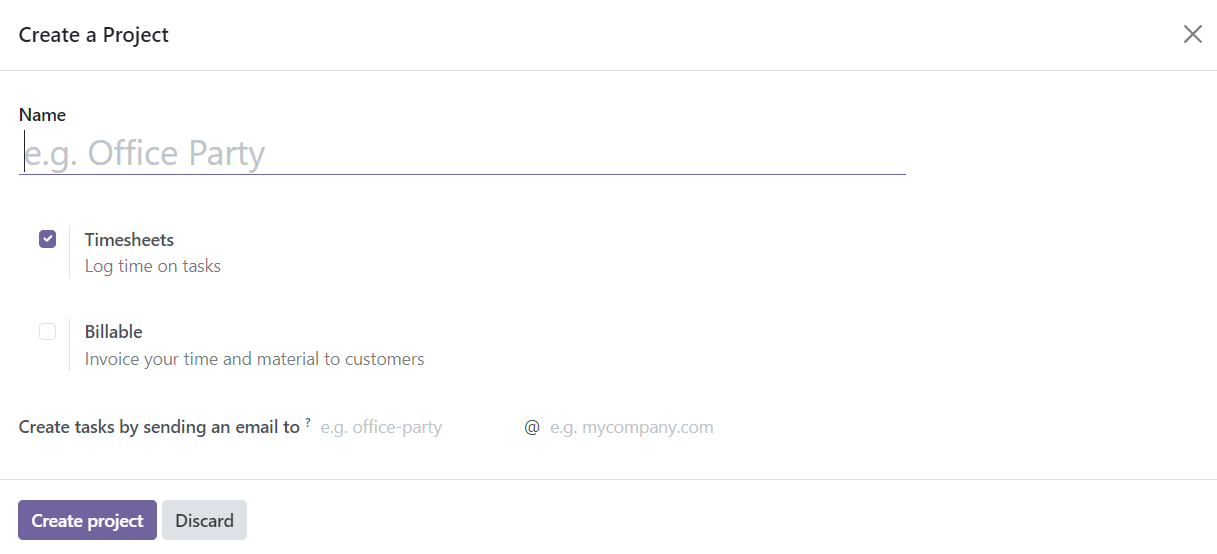
On this project creation page, you will see various options, including a Billable field that enables you to invoice time and materials used on the project directly. When you activate the Timesheet option below, the project will be automatically linked to timesheet tracking, allowing for precise recording of hours worked. Once all the necessary details have been filled in, click on Create Project. After creating the project, a new page will appear where you can easily add tasks to your newly created project. The screenshot provided illustrates the new page layout.

On this page, you will find several options, such as placing tasks in designated stages or columns. To add a new column to the list, enter the column title in the appropriate field and click on the Add icon.

Each newly added stage comes with three vertical dots located in the top right corner, which provide access to a small settings menu. This menu includes options like Fold, Edit Stage, Automation, Delete, Archive All, and Unarchive All. These options offer flexibility in managing stages based on the project's requirements.
You can also add new tasks by clicking the + icon. Upon selecting this option, you will be prompted to enter the task title and assign employees to the task.

As mentioned earlier, this section allows you to input task details and make any necessary adjustments.

The three vertical dots on each task provide additional functionality, such as Share Task, Duplicate, and Set Cover Image. This customization enhances the visual organization of your tasks. For example, clicking on the Set Cover Image option will open a box where you can upload and apply a new cover image to the task, as shown in the screenshot.

If you need to modify a task after it has been created, click on the task to make changes. You will see the editing page, which allows you to update key details such as task name, project name, list of assignees, milestones, and task deadlines.
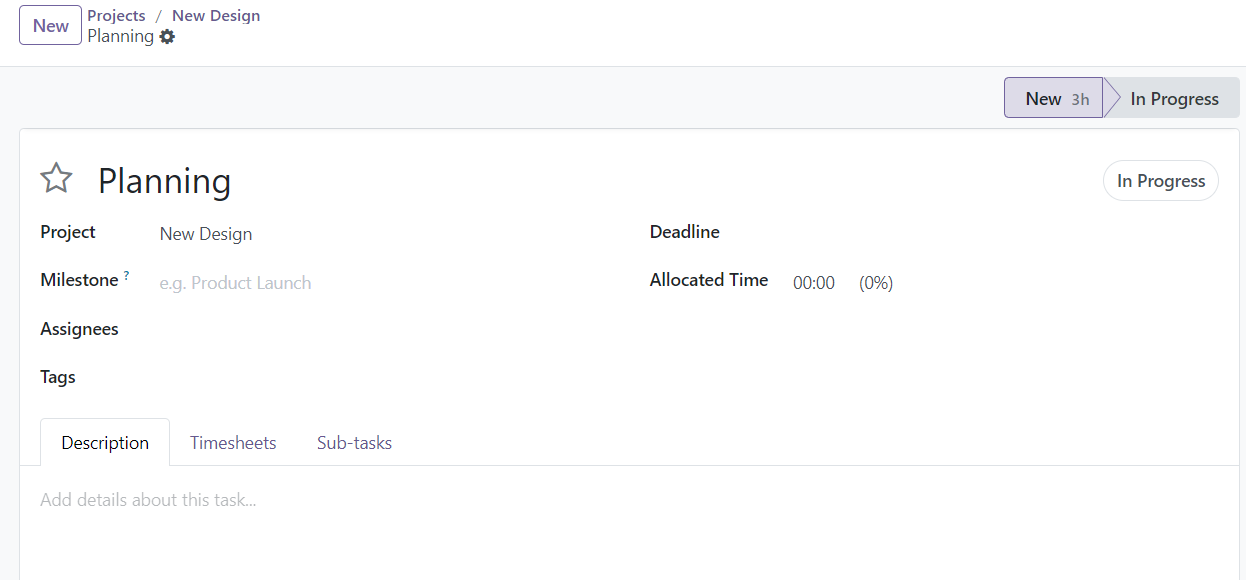
You can also add Tags and set Allocated Time if necessary. If you are working on a project with billable tasks, Odoo allows you to create sales orders for customer invoicing. You can track the time spent on a task and automatically link it to the invoicing process.

For tasks that repeat over specific intervals, Odoo 18 offers the Recurring Task feature. This feature can be enabled from the Configuration Settings and allows tasks to be repeated automatically at predetermined intervals.
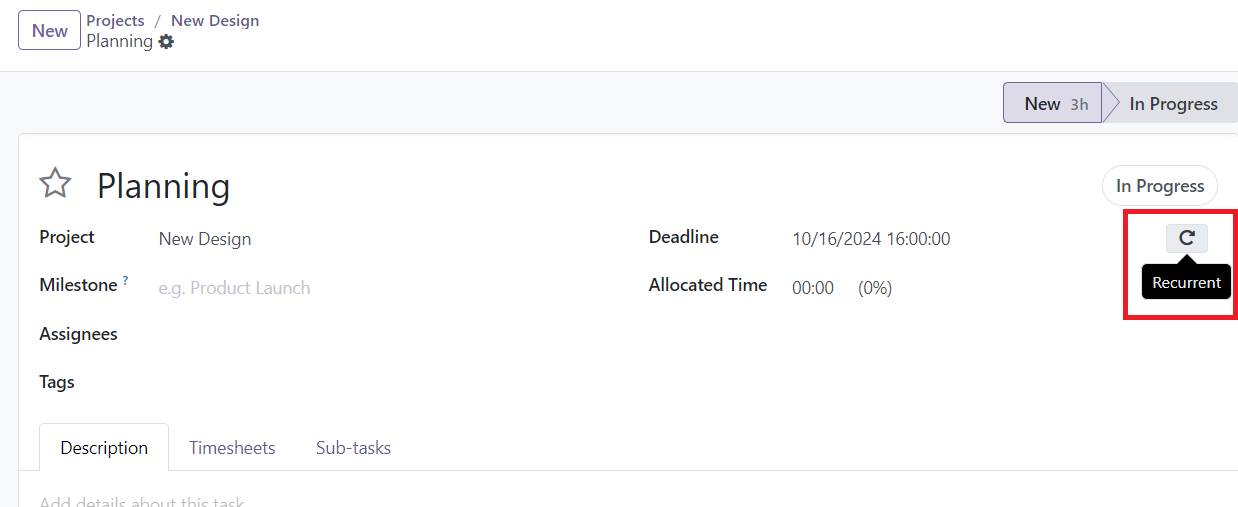
After setting a deadline for the task, you can click the Recurrent button next to the deadline field. A new field called Repeat Every will appear, where you can specify the repeat interval.
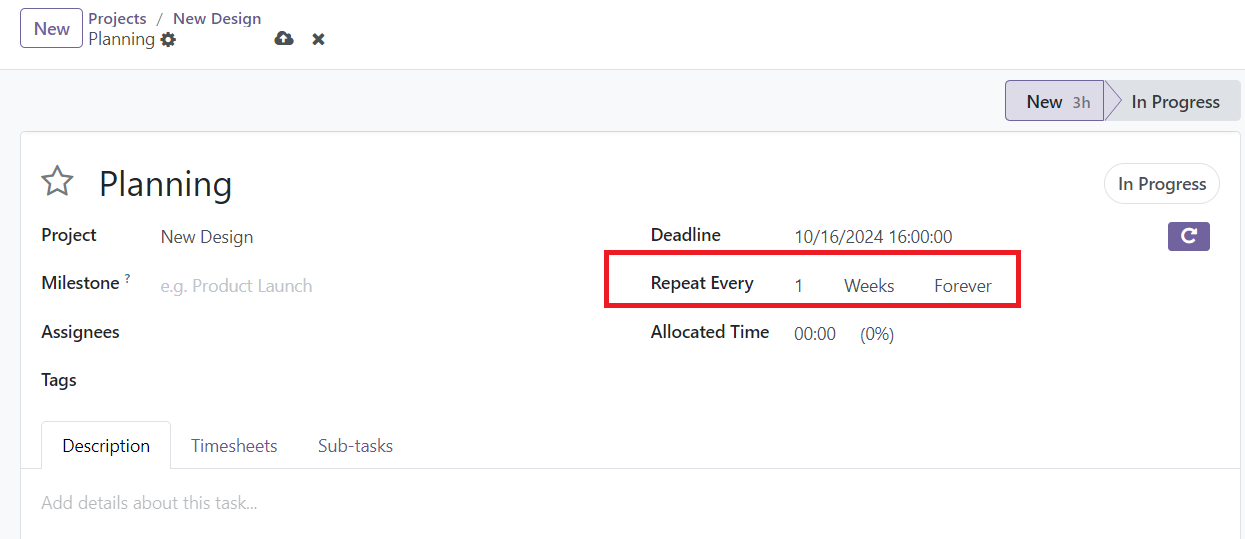
Odoo also provides tools to track the dates associated with task recurrence, ensuring that the task will continue even after the current instance is marked as completed.
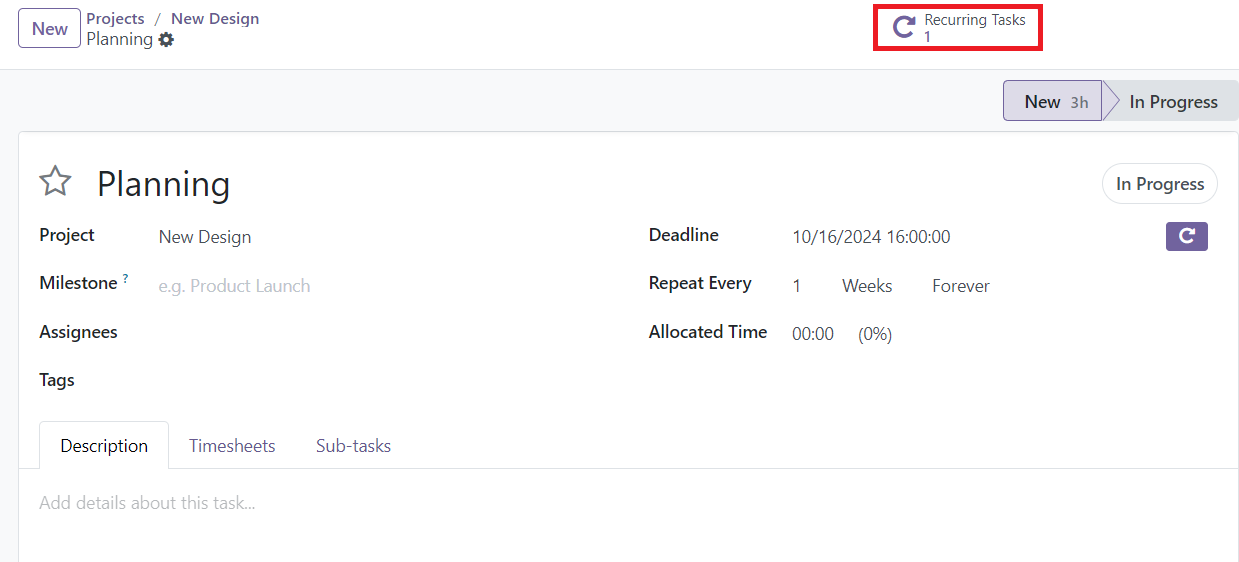
The Timesheet tab, located next to the description tab, is another useful feature. It helps track the hours worked on a task.

When filling out the timesheet, you will need to enter the date, employee name, task description, and hours worked. The Add a Line option allows you to record time entries for each task, ensuring proper time tracking.
Additionally, Odoo 18 allows you to manage complex projects by breaking down tasks into subtasks. The Sub-task tab enables you to divide larger tasks into smaller milestones, improving project management.

You can add details such as the subtask title and assignees. Once the primary task is saved, you can view and manage the newly created subtasks. For projects that require task dependencies, Odoo 18 provides a feature under the Settings option within the Configuration menu.

By enabling the Task Dependencies option, you can define the order in which tasks must be completed. When this option is activated, a Blocked by tab will appear on the task creation page, where you can specify which tasks must be completed before others can start.
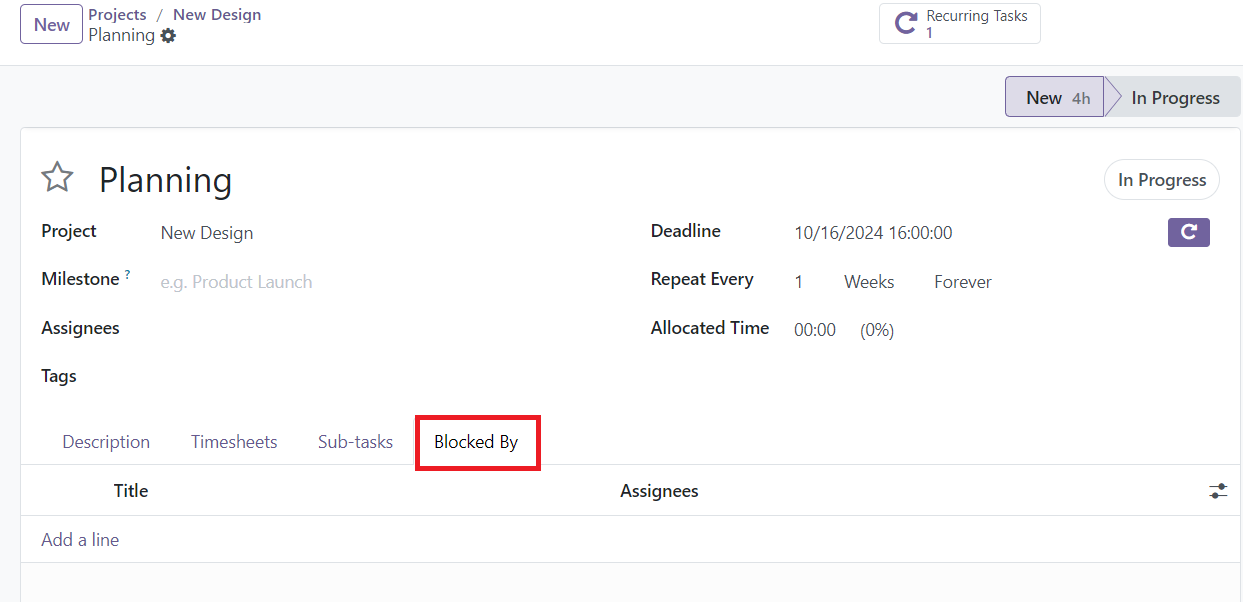
After saving, specific tabs like Sub-task will become visible, allowing you to manage and monitor the task's progress.
In order to manage the configuration of a project separately, you will get the Project option under the Configuration menu of the Project module. Let’s take a look at this option in detail.
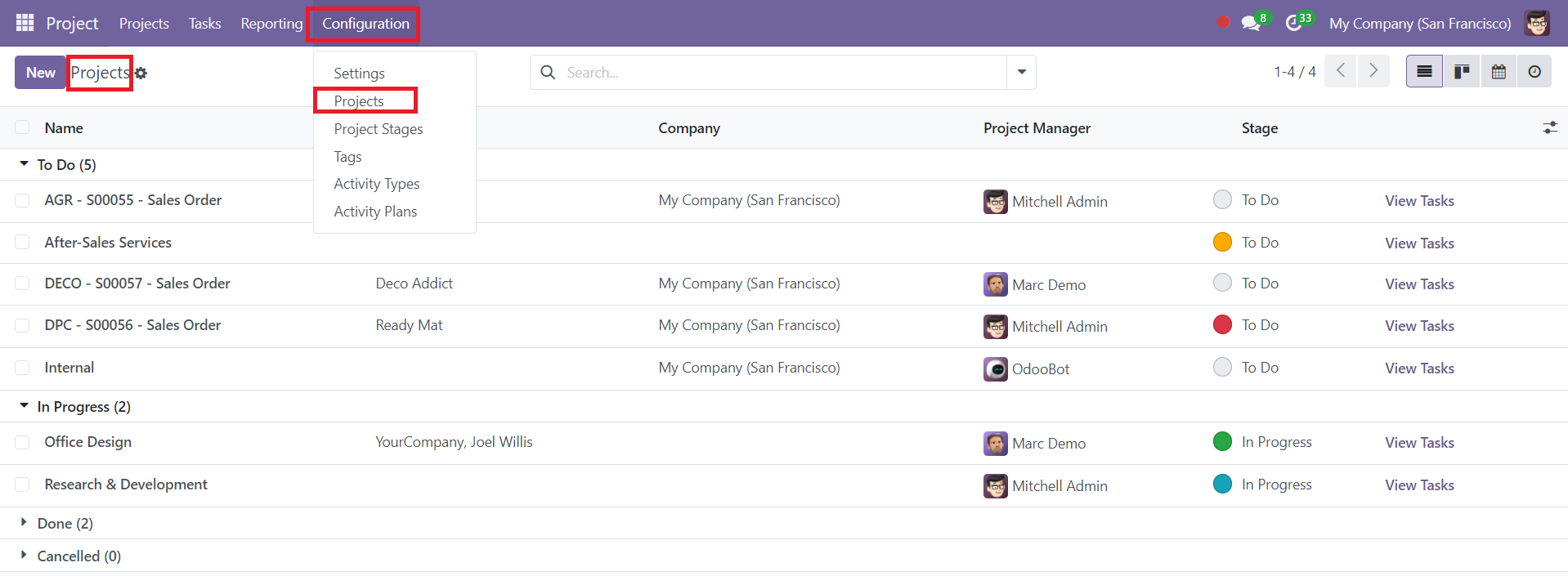
Select the Project option from the menu. This opens the project dashboard, where you'll see a list of existing projects, along with details such as project name, client, company, project manager, and the current project stage. If you want to view the tasks associated with a particular project, simply click the View Task button. Odoo 18 also provides several tools like Group By, Favorites, and Filters to help organize and manage your projects more effectively.
When creating a new project, click the New button on the left side of the project page. This will take you to a project creation form where you can fill in essential fields like the project name, task names, customer, relevant tags, company, project manager, planned dates, and the number of hours allocated for the project.
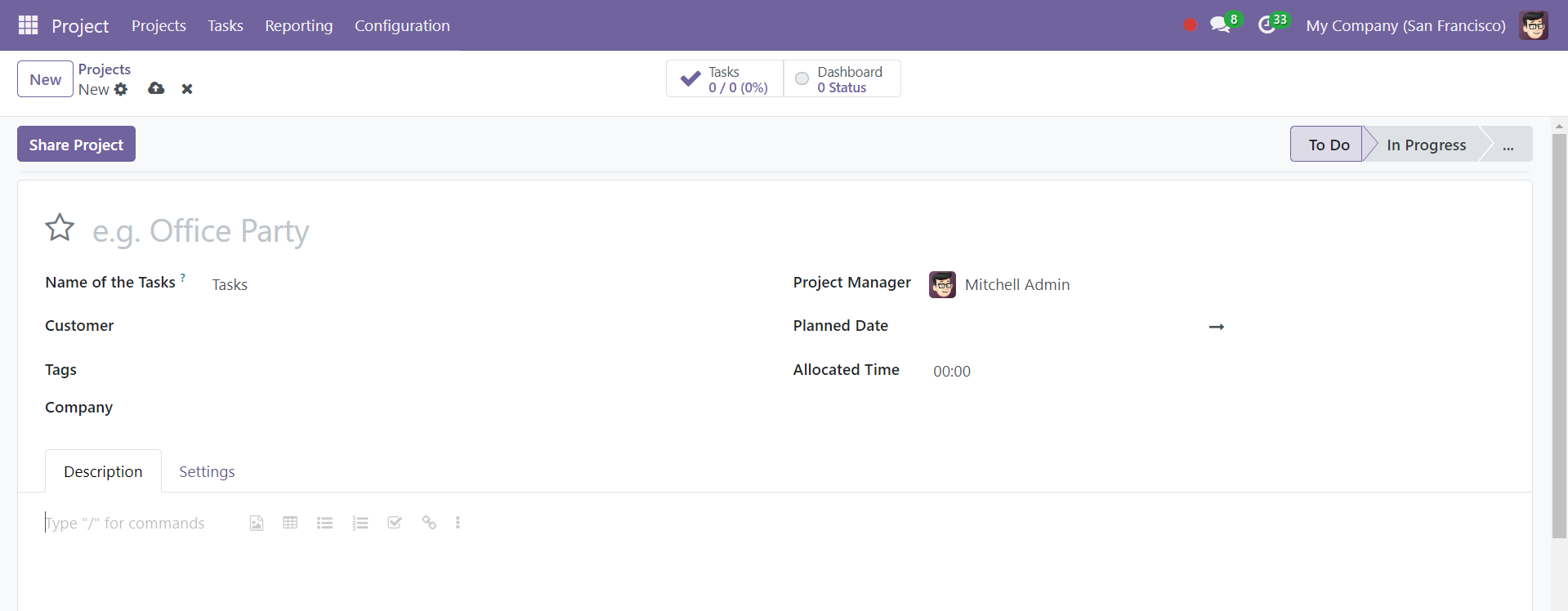
Below these fields, you will find two tabs: Settings and Description. The Description tab allows you to provide a detailed overview of the project, including specific instructions and links to relevant documents. In the Settings tab, you can configure advanced settings such as project visibility, task management options, time tracking, and invoicing.
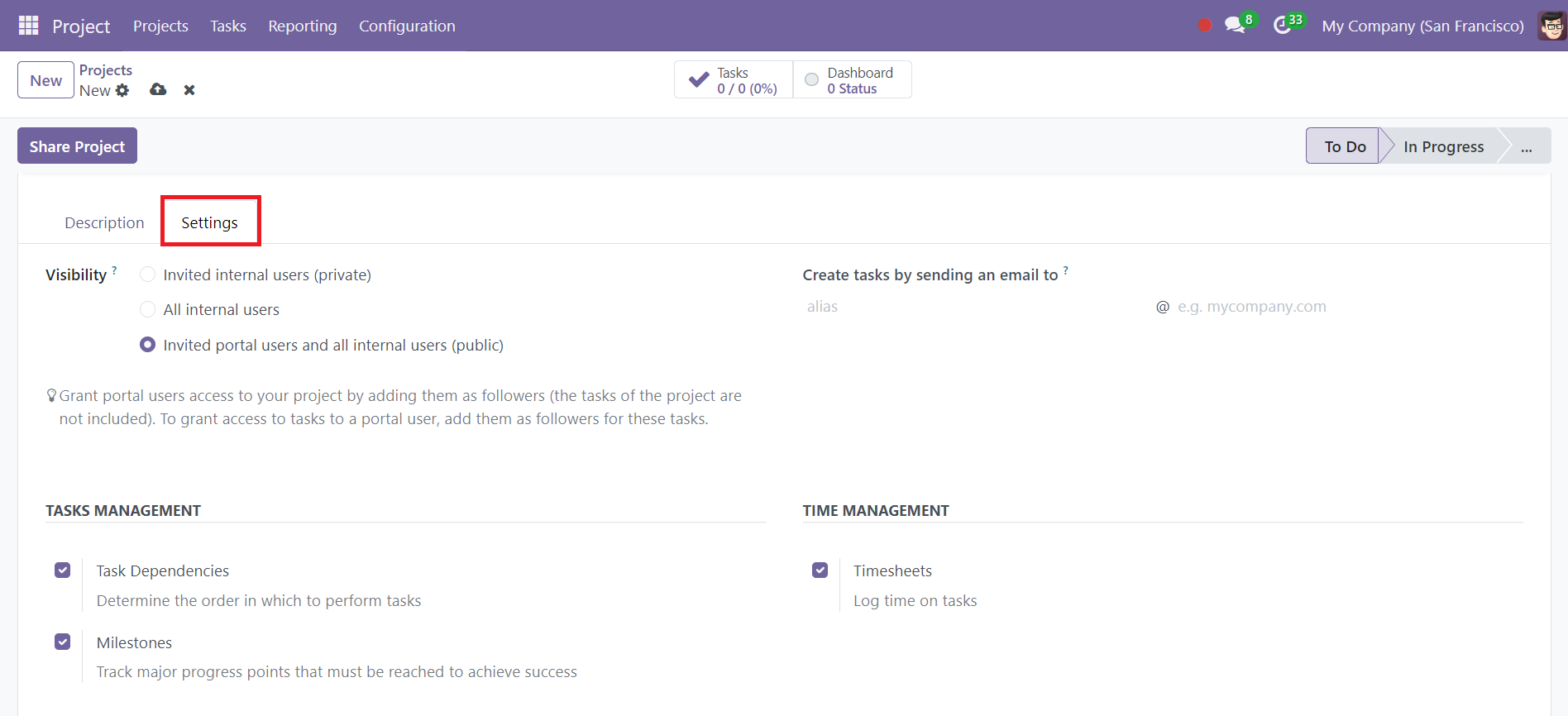
In the Settings tab, you have several important options to customize your project. You can control the project’s visibility by selecting Invited Internal Users, All Internal Users, or Invited Portal Users and All Internal Users. This allows you to restrict or grant access to specific users, and you can also add relevant users as Followers to keep them updated on project progress. Under the Task Management section, you can enable Task Dependencies to ensure tasks are completed in a specific order and activate the Milestones feature to track significant project achievements. Additionally, the Time Management section allows you to enable Timesheets for logging time spent on tasks, ensuring accurate reporting.
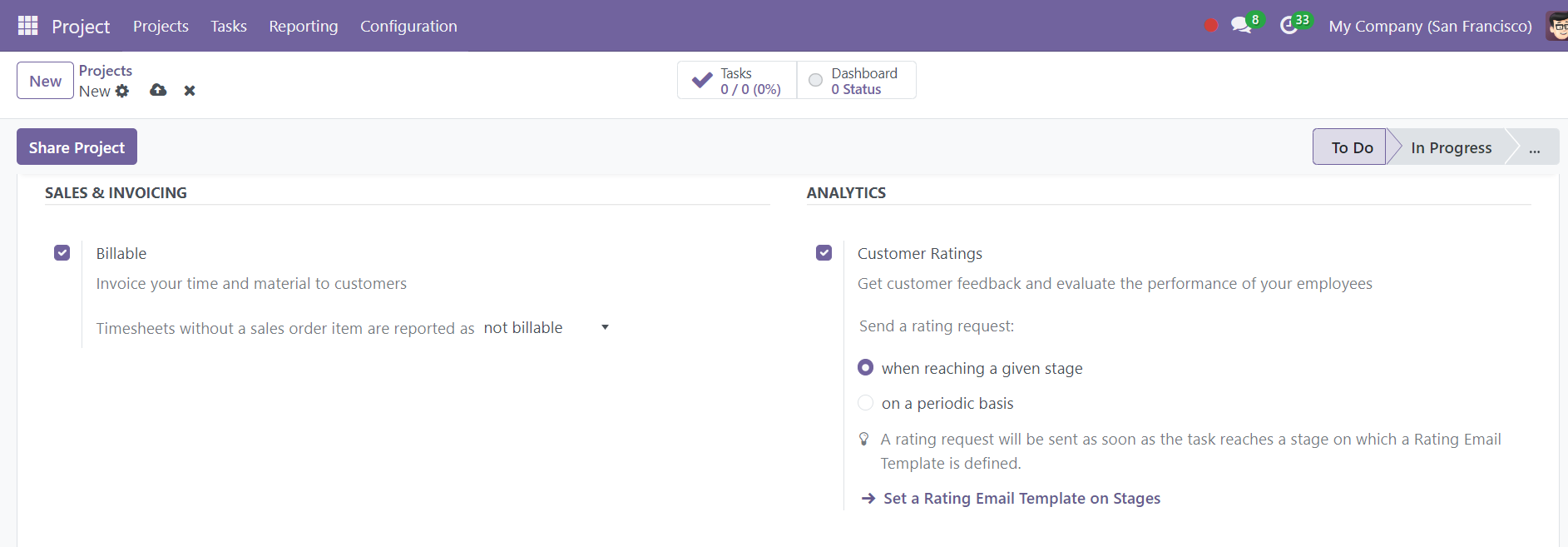
For billing and invoicing, the Sales & Invoicing section allows you to activate the Billable option, which lets you charge clients for time and materials used. You can also enable the Customer Ratings option under the Analytics section to gather client feedback on task performance. This feature allows you to set up rating requests, which can be triggered periodically or when certain milestones are achieved.
After configuring the project settings, click the Save button to finalize the project. Once saved, an additional option Share Project will appear, allowing you to control how others interact with the project.
When you click on the Share Project button, a pop-up window will appear as shown above. Here, you can select the Access Mode as Edit, Read, or Edit with limited access. Share Read-Only prevents others from making changes, while Share Editable allows external collaborators to contribute to the project. By following these steps, you can efficiently create, manage, and customize projects in Odoo 18, ensuring smooth workflows, accurate time tracking, and enhanced client satisfaction.
Automate Construction Project with Artificial Intelligence
With Odoo 17 Accelerate Your Construction Management Career & Manage And Deliver Successful Construction Projects